A Simple Guide to Brewing with a Chemex
What is a Chemex?
The Chemex is a pour-over style coffeemaker that was invented in 1941 by a chemist named Dr. Peter Schlumbohm. He wanted to design a simple way to brew perfect coffee. His goal was to pull out only the good flavors from the coffee bean, like the oils and caffeine.

A Famous Design
The Chemex's hourglass shape was inspired by lab equipment, like a flask. It's made from a single piece of special borosilicate glass. This type of glass is strong and doesn't hold onto flavors.
Using this lab glass was an important choice. It can handle boiling water without cracking. Most importantly, it doesn't add any chemical tastes to your coffee.
The simple design, with its glass body, wood collar, and leather tie, was a big hit. It was even put on display at the Museum of Modern Art (MoMA) in New York. It's still part of the museum's collection today.
The Secret is the Filter
The real magic of the Chemex comes from its special paper filters. These filters work together with the glass carafe to make a unique cup of coffee. They are the key to the whole process.
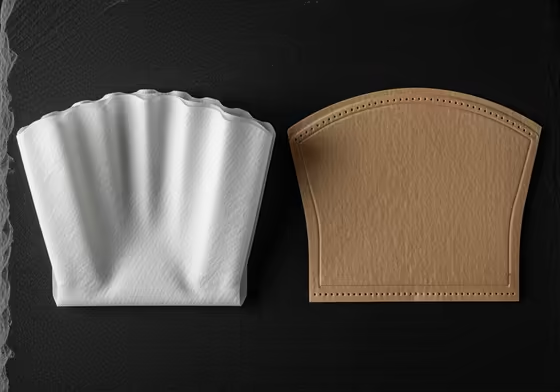
Chemex filters are 20-30% thicker than regular coffee filters. They are designed to trap certain parts of the coffee. This includes bitter fats, extra acidity, and any small coffee grounds.
This strong filtration is why Chemex coffee is known for being so clean . It removes the heavier stuff that can make coffee taste muddy. This lets the lighter, fruity, and floral flavors stand out more clearly.
What's the Glass Bump For?
That small glass bump on the side of the carafe isn't just for looks. It's a simple way to measure your coffee. It helps you see how much you've brewed.
- On the 6, 8, and 10-cup models, the bump marks the halfway point.
- The bottom of the wood collar usually marks the full line on these models.
- But on the small 3-cup model, the bump marks the full capacity.
How to Brew with a Chemex
To make great coffee every time, you need to balance four things: the amount of coffee and water, the grind size, the brewing time, and the water temperature.
While the Chemex is simple, you really need three tools to get consistent results. This guide assumes you have them.
- A Digital Scale: To measure coffee and water in grams, not scoops.
- A Burr Grinder: To get an even and adjustable grind.
- A Gooseneck Kettle: To pour water slowly and with control.
Step-by-Step Guide for Two People
This recipe is for making two good-sized mugs of coffee using a 6-cup Chemex. It uses a 1:16 coffee-to-water ratio.
- Coffee: 40g
- Water: 640g
- Grind: Medium-Coarse (like chunky sea salt)
- Water Temp: 200°F - 205°F
- Total Time: 4:30 - 5:30 minutes
Step 1: Prepare Filter
Open the paper filter so one side has three layers of paper and the other has one. Place the filter in the brewer with the thick, 3-layer side facing the pour spout. This is really important for proper airflow.
Step 2: Rinse and Preheat
Pour hot water over the filter to rinse away any paper taste. This also warms up the glass, which helps the coffee brew better. Carefully pour out the rinse water, keeping the filter in place.
Step 3: Add Coffee and Zero Out Scale
Add 40g of medium-coarse ground coffee into the filter. Give it a little shake to make the grounds level. Place the whole Chemex on your scale and press the tare or zero button.
Step 4: The Bloom (0:00 - 0:45)
Start your timer and pour about 80g of water over the grounds, making sure to wet them all evenly. Wait for 45 seconds. You'll see the coffee puff up, which is called the bloom .
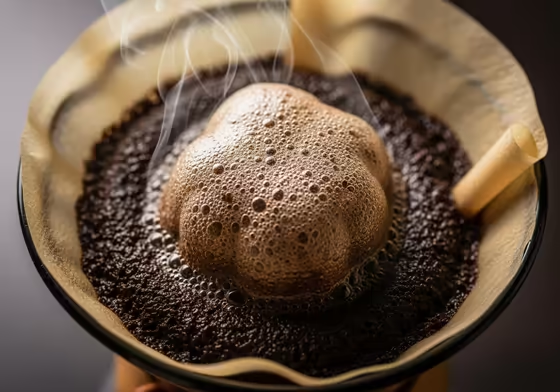
Step 5: The Main Pour (0:45 - 2:30)
Now, slowly pour the rest of the water in a few stages. Try to pour in slow circles.
- At 0:45, start pouring until the scale reads 280g.
- At 1:30, pour again until the scale reads 460g.
- At 2:30, pour the last of the water until you reach the final weight of 640g.
Step 6: The Drawdown (2:30 - 5:00)
Let all the water drip through the coffee. This should finish around the 4:30 to 5:30 minute mark. If it's much faster, your grind is too coarse. If it's much slower, your grind is too fine.
Step 7: Serve
Lift out the filter and throw it away. Give the Chemex a gentle swirl to mix the coffee. Then pour and enjoy your hard work.
Getting the Coffee and Water Ratio Right
Many guides suggest using tablespoons , but that's not very accurate for great coffee. Different beans have different densities, so a scoop of one can weigh more than a scoop of another. Using a scale to measure in grams is the only way to be consistent.
A great starting ratio for a Chemex is 1:16. This means 1 gram of coffee for every 16 grams of water. You can adjust this to 1:14 for a stronger cup or 1:18 for a lighter one.
Don't worry about measuring in cups , because a coffee cup isn't a standard size. A Chemex cup is 5 ounces, but a normal mug might hold 12 ounces or more. Just decide how much coffee you want to make in grams, and use your ratio to figure out how much coffee you need.
| Desired Brew | Coffee Dose (at 1:16) | Total Water to Add | Recommended Brewer Size |
|---|---|---|---|
| 1 Small Cup (~8 oz) | ~15g | 240g | 3-Cup Chemex |
| 1 Large Mug (~12 oz) | ~22g | 352g | 6-Cup Chemex |
| 2 Mugs (~24 oz) | ~42g | 672g | Ideal for 6-Cup Chemex |
| 3 Mugs (~36 oz) | ~64g | 1024g | 8-Cup or 10-Cup Chemex |
Why Grind Size Matters
For a Chemex, you need a medium-coarse grind. It should look like coarse sea salt or kosher salt. It needs to be clearly coarser than what you'd use for a normal drip coffee maker.
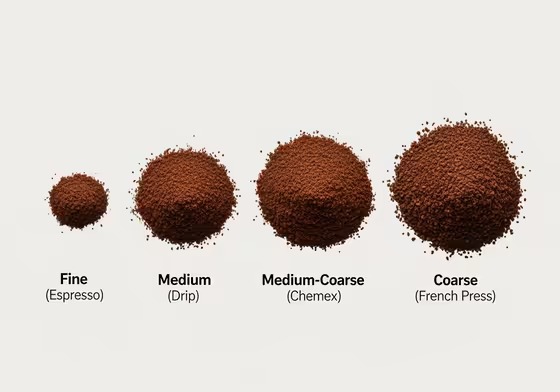
This specific grind size is necessary because of the thick Chemex filter.
- The filter paper is very thick, so water flows through it slowly.
- If you used a normal medium grind, the small coffee particles would clog the slow filter.
- This would make the water sit with the coffee for too long.
- That leads to over-extraction, which makes coffee taste very bitter.
- So, a medium-coarse grind creates more space for water to flow, hitting the target brew time and making a balanced cup.
Your grind size is the main thing you'll adjust to perfect your coffee. Let taste be your guide.
- If the coffee tastes BITTER , the brew was too slow. Grind COARSER .
- If the coffee tastes SOUR or WEAK , the brew was too fast. Grind FINER .
Time and Temperature Tips
For a normal batch in a 6-cup brewer, the total brew time should be between 4:30 and 6:00 minutes. Smaller batches will be faster, around 3:30 to 4:00 minutes.
The first 30 to 45 seconds of that time is the bloom . This step is important because it lets trapped CO2 gas escape from the coffee grounds. If you skip it, the gas can push water away and cause an uneven, weak brew.
The best water temperature is just below boiling, between 197°F and 205°F. But you can adjust this based on the type of coffee you're using.
- For Light Roasts: Use hotter water (203°F - 212°F). Lightly roasted beans are harder to extract flavor from, so they need the extra heat.
- For Dark Roasts: Use cooler water (185°F - 195°F). Dark roast beans are more brittle and extract very easily, so hot water can make them taste burnt and bitter.
How to Use the Filter Correctly
The special Chemex filters are a must. They come in a few shapes, but the square ones are most common.
Here is how to fold and place the filter.
- Open a square filter into a cone. You'll see one side has a single layer of paper, and the other has three layers.
- Place the cone in the Chemex with the 3-LAYER SIDE facing the pouring spout.
This placement is the most common mistake people make, but it's very important. The spout is the only place for air to escape as the coffee brews.
If you put the thin side against the spout, it can get wet and stick to the glass, blocking the air channel. This creates a vacuum that stops the coffee from dripping. The thick 3-layer side won't collapse, so it keeps the air channel open and lets the brew flow correctly.
You can't really use normal coffee filters in a Chemex. First, they are too thin and might rip open, spilling grounds everywhere. Second, the whole point of a Chemex is its thick filter, which creates that signature clean flavor.
Reusable metal or cloth filters are an option, but they will completely change the coffee.
- Paper filters remove all oils and sediment for a clean, tea-like cup.
- Metal filters let oils and some sediment through. This makes a richer, fuller-bodied coffee, more like a French Press.
- Cloth filters are a middle ground. They let oils through for body but block the sediment, creating a balanced, juicy cup.
The Best Coffee Beans for a Chemex
A Chemex is all about clarity. Its thick filter is perfect for showing off the complex and delicate flavors of light and medium roast coffees.
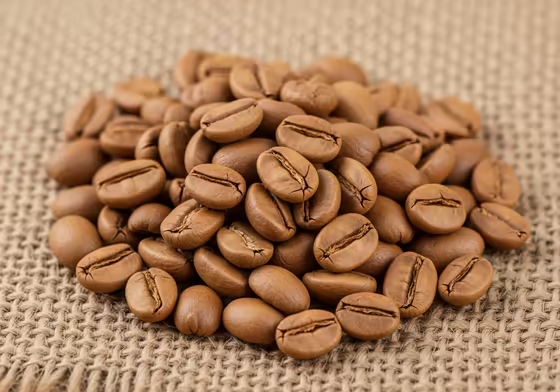
Using a dark roast in a Chemex doesn't make much sense. The filter removes the heavy oils and body that you want from a dark roast. This can leave you with a boring or burnt-tasting cup.
On the other hand, the filter is perfect for light roasts. It removes any muddy flavors that might hide the coffee's bright, fruity, and floral notes. This lets the bean's true character shine.
For the best results, look for single-origin beans with bright flavors.
- Ethiopian: These coffees are often tea-like, with floral and citrus notes that are perfect for a Chemex.
- Kenyan: Known for a bright, juicy flavor, often with hints of blackcurrant.
- Central American: Beans from places like Guatemala or Colombia also work well, giving you a very clean and balanced cup.
Always use whole beans that were roasted recently. Grind them right before you start brewing. Pre-ground coffee loses its flavor quickly and will taste flat.
Fixing Bad Chemex Coffee
If your coffee doesn't taste good, the problem is almost always with the extraction . This just means the water pulled either too much or too little flavor from the grounds.
If Your Coffee is Bitter
- The Problem: Over-extraction. The water touched the coffee for too long or was too hot, pulling out bitter flavors.
-
How to Fix It (try in this order):
- Grind Coarser. This is usually the problem. A finer grind slows down the water too much.
- Use Cooler Water. If your water is too hot, it will pull out bitter flavors fast. Let it cool a bit after boiling.
- Check Your Ratio. Too much coffee for the amount of water can also taste bitter.
If Your Coffee is Sour or Weak
- The Problem: Under-extraction. The water ran through the coffee too fast or wasn't hot enough to pull out the sweet flavors.
-
How to Fix It (try in this order):
- Grind Finer. This is the most common fix. A finer grind will slow down the water and increase extraction.
- Use Hotter Water. Your water might be too cool to properly extract the coffee, especially for light roasts.
- Check Your Ratio. A weak taste can be caused by using too much water for the amount of coffee.
If Your Coffee Tastes Flat
- The Problem: This is often caused by heat loss. The glass carafe can cool down the water too much during the long brew time.
- The Heat Sink Problem: The Chemex is a big piece of glass, and it pulls heat away from the coffee and water mixture. This can stall the brewing process halfway through. The result is a cup that is clean but tastes dull or lifeless.
-
How to Fix It:
The Heat Sink Problem: The large glass body of the Chemex can pull heat out of your coffee slurry, causing the extraction to stall. To prevent a flat-tasting cup, always preheat the brewer thoroughly with plenty of hot water before adding your grounds.
- Preheat Well. This is the most important step. Use plenty of hot water to rinse the filter and get the whole brewer hot before you start.
- Stir or Swirl. You can gently stir the grounds during the bloom or give the Chemex a swirl after your final pour. This helps all the coffee get extracted evenly.
- Check Your Beans. The coffee might taste flat because the beans are old or low quality. Try a fresh, bright coffee from a good roaster.
Chemex vs. Other Coffee Makers
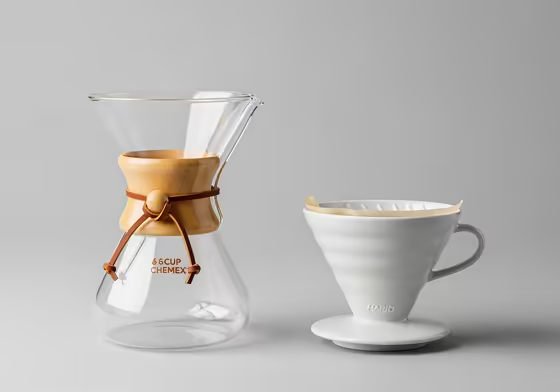
Is a Chemex a Pour-Over?
Yes, the Chemex is a type of pour-over brewer. It's just a specific brand and style within that category. It is a bit different from other pour-over brewers like the Hario V60 or Kalita Wave.
The main differences are its all-in-one carafe design and its very thick paper filter. This filter is the main reason a Chemex produces a cup with such a clean and light taste. Other brewers use thinner filters that create a bolder cup with more body.
Chemex vs. V60
This is a classic comparison in the coffee world. The Chemex and Hario V60 are both pour-over brewers, but they are designed to make very different styles of coffee.
| Feature | Chemex | Hario V60 |
|---|---|---|
| The Filter | Very thick, bonded paper. | Thin, cone-shaped paper. |
| Brewer Design | Smooth glass walls, single piece. | Spiral ridges inside and a big hole at the bottom. |
| Flow Rate | Slow, because of the thick filter. | Fast, because of the thin filter and ridges. |
| Grind Size | Medium-Coarse (to speed up the slow flow). | Medium-Fine (to slow down the fast flow). |
| Ease of Use | More Forgiving. The thick filter makes your pouring technique less important. | Hard to Master. Very sensitive to how you pour the water. |
| Taste Profile | Clarity. Bright, clean, and tea-like. | Complexity. Balanced, bold, with more body. |
| Best For | Delicate light roasts and making bigger batches. | Someone who wants to master a technique; great for single cups. |
Can a Chemex Make Espresso?
No, it's impossible to make real espresso with a Chemex. The two brewing methods are completely different.
- Chemex uses gravity to slowly drip water through coffee grounds over several minutes.
- Espresso uses very high pressure to force hot water through a tight puck of fine coffee in about 30 seconds.
A Chemex can't create the pressure needed for espresso. If you tried to use fine espresso grounds in a Chemex, it would immediately clog the filter and make a bitter, muddy mess.
Other Chemex Gear
The Chemex Automatic Brewer
Chemex sells an automatic coffee maker called the Ottomatic 2.0. It's a machine designed to brew coffee for you using a standard Chemex carafe.
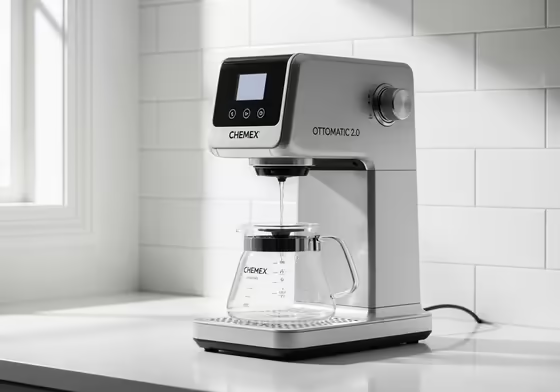
The machine handles the tricky parts of brewing. It heats water to the right temperature and even does a pre-infusion or bloom cycle. Then, a special sprayhead pulses water over the coffee to act like a person pouring.
The Ottomatic is very expensive, costing around $350. While it's convenient, reviews say it can't match a careful manual brew. It's a good machine for someone who loves the Chemex look but wants the ease of pushing a button.
How to Clean Your Chemex
For daily cleaning, the glass carafe is dishwasher safe if you remove the wood collar first. You can also just wash it by hand with warm, soapy water and a bottle brush.
For a deep clean to remove coffee stains, you can soak the carafe in a mix of white vinegar and water. You can also scrub the inside using a mix of coarse salt and crushed ice. Just swirl it around vigorously.
Taking care of the wood collar is critical. Never put the wood collar or leather tie in the dishwasher or soak it in water. The wood will warp and crack, and the leather will get ruined. To clean it, just wipe it down with a damp cloth and dry it right away.